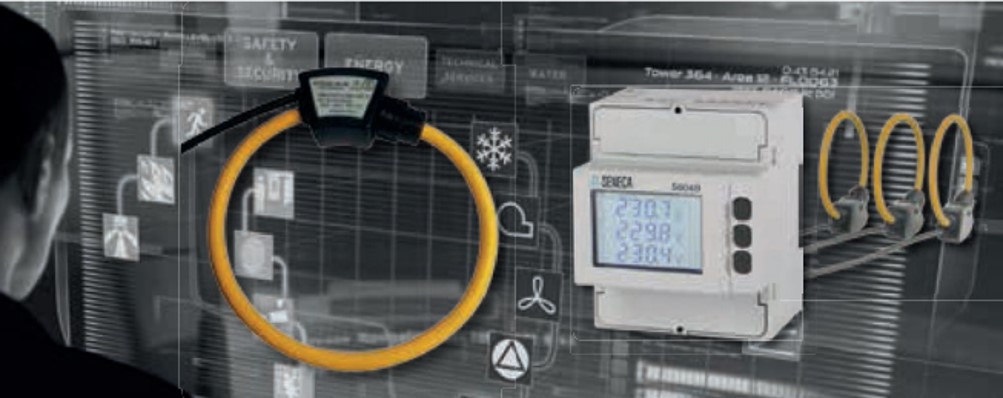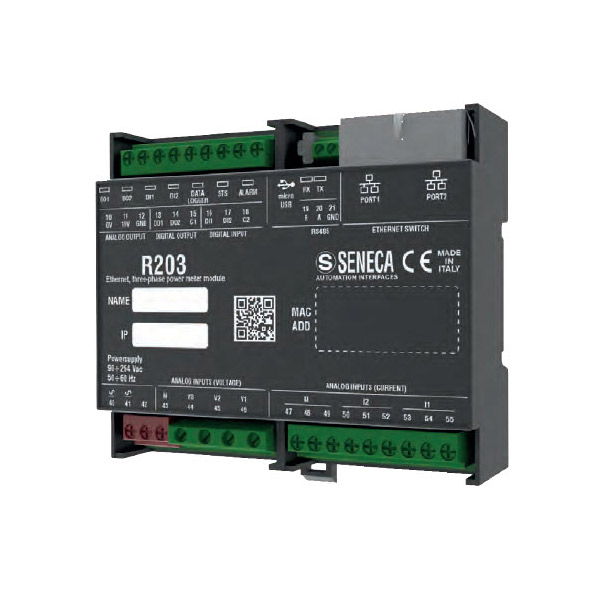 https://blog.seneca.it/wp-content/uploads/2020/11/Sfondo_S604.jpg
https://blog.seneca.it/wp-content/uploads/2020/11/Sfondo_S604.jpg
Power Meters are devices designed to detect the characteristics of the power supply in single-phase or three-phase networks and utilities. They allow the energy and power analysis and therefore the control of the quality of the power supply. They can also be used to continuously record the trend of the alternating quantities available. These instruments are suitable for applications in all industrial and civil sectors with different levels of precision and standards (for example according to IEC 61000, IEC61010, EN 50160 standards). The market offers a wide variety of them.
Basic measurements
In the simplest versions the network analyzers are used in single-phase or three-phase three- or four-wire systems with the possibility of data transmission via data communication interface (e.g. ModBUS, Ethernet) of all the main characteristic quantities of a power network, including active and reactive energy counts. In some cases they have programmable alarms or pulse outputs for parameter retransmission. Frequently the measurement of the basic quantities (voltages and currents) is performed with the sampling method, which by its nature allows the correct calculation of the true rms value (TRMS) even in the presence of distorted waveforms, increasingly frequent in modern electrical installations.

Electric noise monitoring
Basically there are two types of network disturbances to monitor: persistent and occasional. The former can be addressed with clamp multimeters with true rms measurements and oscilloscopes with differential inputs. For the latter it is preferable to use network noise analyzers. To detect repetitive noise, it is common practice to measure the true rms value with a multi-function device or clamp-on multimeter and display the waveforms of the three phases that power the equipment with a differential input oscilloscope.
Power Quality Test and Troubleshooting
There are two basic categories of power quality analyzers (PQM, Power Quality Meters) on the market: those for the verification of the quality of the supplied voltage (with detection of harmonics and flicker) and those for troubleshooting. The former are effective statistical tools but do not solve problems due to occasional disturbances. The latter are identified by the power grid quality analyzers, which provide long-term monitoring with automatic capture of voltage and current waveforms during disturbed periods. The purpose of the monitoring is to capture the events that have created problems in the equipment. Another problem, but no less important, is the location of the network disturbance analyzer. It is good practice to monitor the power supply network as close to the equipment as possible.
Troubleshooting analyzers generally provide features in addition to the continuous monitoring of a network’s isolation from ground, which can help to further increase the level of safety and reduce costs such as automatic isolation fault detection, which can occur during operation. This increases plant availability considerably and minimizes downtime.
Harmonics Analysis
The use of analyzers in installations is also useful to detect the effects of transients and harmonics. The sudden change in the electric waveform, due to the power failure, causes transients for several thousand volts. Switching peaks of power converters also cause considerable interrupting effects. The low voltages with which modern microelectronic devices operate make them more susceptible to interference from the power supply network. In addition to the effect on electronic devices, these transients can also cause interference with a data or control network. Another central problem, given the large amount of industrial and consumer equipment operating with rectified mains voltages, is the introduction of harmonics in distribution systems.
Vector Analysis
Last but not least, precision devices that verify electrical performance and network vector analysis (VNA) should be considered. They are based on one of the main measurement techniques used in the radio frequency and microwave sector. These systems allow the analysis of passive and active components such as filters, amplifiers, mixers and multi-port modules. The hardware of vector network analyzers is optimized for high measurement speed using frequency scanning, so that results are obtained faster than using a single signal source combined with a receiver such as a spectrum analyzer. Through calibration operation, vector network analyzers offer the highest level of accuracy when measuring radio frequency components.
SENECA offer
Series 203: equipment specifically designed to detect the characteristics of the power supply in single-phase or three-phase networks and utilities. They allow the energy and power analysis and therefore the control of the quality of the power supply. They support the ModBUS RTU communication protocol.
S604 Series: innovative multifunction instruments for measuring and storing electrical parameters. The excellent price/performance ratio and the versatility in supporting the ModBUS TCP-IP and ModBUS RTU communication protocols make them ideal for power consumption analysis and control. The KIT versions sold in combination with Rogowski current transducers offer extreme ease of connection even in environments with reduced operating space.
S711 Series: innovative multifunction instruments for the measurement and storage of electrical parameters. These panel-front analyzers, thanks to the large high brightness display, guarantee a clear and immediate consultation of information.
| S203TA-D | S203RC-D | R203 | S604B-6-MOD (S711B6MOD) | S604B-6-ETH | S604B-80-MOD | S604B-80-ETH | |
| Accuracy class | 0,2% | 0,5% | 0,2 / 0,5% | 0,5% | 0,5% | 0,5% | 0,5% |
| Harmonic monitoring | x | ||||||
| Ethernet interface | x | x | x | ||||
| RS485 Modbus RTU interface | x | x | x | x | x | ||
| Analog output retransmitted | x | x | x | ||||
| Digital output (alarm / pulses) | x | x | x | x | x | ||
| Datalogging (average values) | x | x | x | x | x | ||
| Datalogging (min/med/mx values) | x | ||||||
| Energy Metering | x | x | x | x | x | x | x |
| Stellar tension measurement | x | x | x | x | x | x | x |
| Linked voltage measurement | x | x | x | x | x | ||
| Aron three-phase measurements | x | x | |||||
| Single-phase measurements | x | x | x | x | x | x | x |
| Individually configurable TA | x | x | x | x | |||
| External CT | 5A | 1/5 A | 1/5A | 1/5A | |||
| Direct insertion | x | 80A | 80A | ||||
| Rogowski sensor | x | x | |||||
| Power supply | 10-40 Vdc; 19-28 Vac | 10-40 Vdc; 19-28 Vac | 90..264 VAC | 85..265VAC | 85..265VAC | 85..265VAC | 85..265VAC |
| Programming | tasti frontali EASY SETUP | tasti frontali EASY SETUP | Tasti frontali; Energy Power Pack | Tasti frontali; Energy Power Pack | Tasti frontali; Energy Power Pack | Tasti frontali; Energy Power Pack | |
| Web server monitoring | x | x | x |